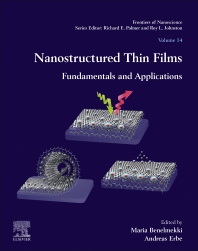Nanostructured Thin Films
Fundamentals and Applications
- 1st Edition, Volume 14 - August 25, 2019
- Editors: Maria Benelmekki, Andreas Erbe
- Language: English
- Paperback ISBN:9 7 8 - 0 - 0 8 - 1 0 2 5 7 2 - 7
- eBook ISBN:9 7 8 - 0 - 0 8 - 1 0 2 5 7 3 - 4
Nanostructured Thin Films: Fundamentals and Applications presents an overview of the synthesis and characterization of thin films and their nanocomposites. Both vapor phase and… Read more

Purchase options
Institutional subscription on ScienceDirect
Request a sales quoteNanostructured Thin Films: Fundamentals and Applications presents an overview of the synthesis and characterization of thin films and their nanocomposites. Both vapor phase and liquid phase approaches are discussed, along with the methods that are sufficiently attractive for large-scale production. Examples of applications in clean energy, sensors, biomedicine, anticorrosion and surface modification are also included. As the applications of thin films in nanomedicine, cell phones, solar cell-powered devices, and in the protection of structural materials continues to grow, this book presents an important research reference for anyone seeking an informed overview on their structure and applications.
- Shows how thin films are being used to create more efficient devices in the fields of medicine and energy harvesting
- Discusses how to alter the design of nanostructured thin films by vapor phase and liquid phase methods
- Explores how modifying the structure of thin films for specific applications enhances their performance
Researchers in academia, government and industry working in the fields of materials science, engineering and physics
1. Nanostructured thin filmsebackground, preparation and relation to the technological revolution of the 21st century
2. Micro- and nanostructured piezoelectric polymers: fundamentals and application
3. Nanostructured flexible PVDF and fluoropolymer-based hybrid films
4. Two-dimensional nanostructures for biomedical applications
5. Nanostructured magnetite thin films: an avenue for spintronics
6. Dynamic effects in siloxane PECVD coatings
7. Scanning thermal microscopyda tool for thermal measurement in the nanoscale
8. Interface and surface properties of oxideeorganic hybrid nanostructures: from charge transfer to degradation effects
9. Coatings and surfaces with hydrophobic and anti-icing properties
10. Spectroscopic and electrical properties of hybrid thin films for solar cell applications
11. Biomedical applications of ultrathin atomic layer deposited metal oxide films on polymeric materials
- No. of pages: 334
- Language: English
- Edition: 1
- Volume: 14
- Published: August 25, 2019
- Imprint: Elsevier
- Paperback ISBN: 9780081025727
- eBook ISBN: 9780081025734
MB
Maria Benelmekki
AE